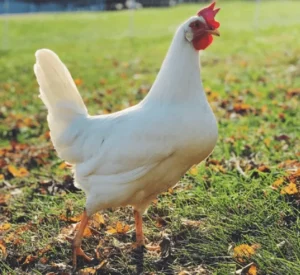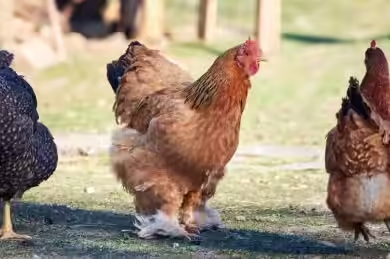Last updated on August 7, 2025
Leghorn chickens typically start laying their first eggs around 16 to 18 weeks of age. Known for early maturity, they’re a top choice for backyard keepers seeking quick egg production.
At What Age Do Leghorns Start Laying Eggs?
Leghorn pullets typically begin laying at 16 to 18 weeks of age. Some start as early as 15 weeks, others up to 20. A few weeks’ variance is normal for these point-of-lay pullets.
What Influences the Onset of Laying in Leghorns
Laying onset depends on genetics and environment. Leghorns are bred for early laying.
Key environmental factors include adequate protein feed, 14-16 hours of daylight, and a low-stress coop. These help them stay on track for timely egg production. Because Leghorns are naturally fast maturing, when paired with ideal lighting and nutrition, they often outlay hybrids in the early months.
Signs Your Leghorn Is Ready to Lay
Pullets show signs before laying.
- 🔴 Combs and wattles become larger, redder, and more prominent, signaling hormonal development. These are key pullet maturity signs.
- 🐓 They may also ‘squat’ when approached, a natural mating posture.
- 📦 Increased interest in nesting boxes is another key indicator of their egg-laying behavior.
Observing these clues helps anticipate the first egg. As one seasoned keeper put it, “You’ll see them eyeing those nest boxes like they’re gold, then boom, an egg appears!”
Estimate Your Daily Egg Yield
Tip: This is the percentage of hens laying eggs on a given day.
Enter your flock size and laying percentage to see your estimated daily egg production.
How Long Does It Take for Leghorn Pullets to Mature?
Physical and Behavioral Maturity Timeline
Leghorn pullets mature quickly, both physically and behaviorally.
Physical Development:
- Filling out their body.
- Slightly thicker legs.
- Vibrant comb and wattle color.
Behavioral Changes:
- Shifting from youngsters to purposeful hens.
- Increased nesting box interest.
- More deliberate foraging.
This rapid development contributes to their efficiency as layers.
Differences Between Leghorns and Other Breeds
Leghorns mature faster than many breeds. Heavier breeds like Orpingtons or Australorps take 20-24+ weeks to lay. For consistent, early egg production, Leghorns excel. In my experience, their active nature also makes them fantastic foragers if you allow them to free-range. Want to know more about when Australorps start laying eggs? Explore our full guide on Australorp laying age and what to expect.
What Color and Size Are Leghorn Eggs?
White Leghorn Egg Characteristics
Leghorns lay consistently bright white eggs. They are typically medium to large, often becoming larger as hens mature. Shells are usually strong, beneficial for handling and storage.
Weekly and Daily Egg Output (With Real Numbers)
Leghorns are prolific layers. A healthy hen lays 5 to 6 eggs per week, totaling 280 to 320 eggs per year (Source: Cackle Hatchery and Meyer Hatchery). Their consistency is remarkable, with only a day or two off weekly. Curious how Ayam Cemani egg production compares? Check out our full guide.
Typical Annual Egg Output Comparison
| Breed | Eggs Per Year (Approx.) | Egg Color |
|---|---|---|
| White Leghorn | 280-320 | White |
| Rhode Island Red | 250-300 | Brown |
| ISA Brown | 300-350 | Brown |
| Golden Comet | 250-300 | Brown |
| Australorp | 200-280 | Brown |
How to Support Early and Healthy Laying
Coop Conditions, Light, and Feed Requirements
Support laying by optimizing conditions:
- Feed: Switch 16-18 week pullets to high-quality layer feed (16-18% protein, 3.5-4.5% calcium) for strong eggshells.
- Light: Provide 14-16 hours of light daily; supplement with artificial light in winter. I once had a flock that stopped laying mid-winter, and simply adding a timed light bulb in their coop brought them right back into production. It’s truly a game-changer! In fact, in one instance, my flock went from laying just 3 eggs/week to a robust 20 eggs/week within two weeks of consistent supplemental lighting in February.
- Coop Conditions: Ensure a clean, spacious (3-4 sq ft/bird coop, 8-10 sq ft/bird run), stress-free environment. Offer ample clean nesting boxes (1 per 3-4 hens). For more expert tips, consult 15 simple secrets to raising happy, healthy chickens that actually lay eggs!
How Cleanliness Impacts Egg Production
A dirty coop causes stress and disease, impacting egg production. A messy environment makes hens uncomfortable, reducing or halting laying.
Key Cleanliness Tasks:
- Regularly clean soiled bedding.
- Refresh waterers.
- Ensure mold-free feeders.
Common Mistakes That Delay Laying
Common laying delays include:
- Poor Lighting: Insufficient light, especially in short days.
- Nutritional Deficiencies: Inadequate protein/calcium from incorrect feed.
- Overcrowding: Stress, pecking, and reduced laying from too many birds in small spaces.
- Lack of Nesting Boxes: Hens need private laying spots.
Chicken Coop Size Calculator
Why Your Leghorn Might Not Be Laying Yet
Age-Related Delays (e.g. Is 22 weeks too soon?)
While 16-18 weeks is average, a Leghorn not laying by 20-22 weeks warrants investigation. Delays can occur for various reasons; proactive checking is advised.
Common Lay Blockers by Age Range
Understanding typical issues by age can help pinpoint problems faster:
- 16-18 Weeks (Early Pullets):
- Blockers: Most common issues are insufficient protein in feed (still on grower feed) or not enough light exposure.
- Solutions: Ensure a switch to layer feed with adequate protein and calcium. Confirm they are receiving 14-16 hours of light daily.
- 18-22 Weeks (Late Startes/Early Delays):
- Blockers: Stress (new flock members, predators, loud noises), underlying disease, or seasonal timing (if hatched late in the year).
- Solutions: Review the troubleshooting checklist below. Address any stressors immediately. Observe for signs of illness. Consider supplemental light if days are short.
Stress, Nutrition, and Lighting Factors
Stress, nutrition, and lighting are primary reasons for non-laying.
- Stress: Caused by predators, new birds, noise, or extreme weather.
- Nutrition: Ensure adequate layer feed; avoid excessive treats that dilute nutrients.
- Lighting: Insufficient light, especially in shorter days, is a common problem.
Seasonal Timing and Breed Sensitivities
Laying naturally slows in winter due to reduced daylight. While Leghorns are less affected than some breeds, seasonal timing matters.
Pullets hatched in late summer/fall may delay laying until spring, even with supplemental light. Sometimes, all it takes is a bit of patience, as a poultry vet once told me: "Chickens aren't robots; they'll lay when conditions are right for them." This sentiment was echoed by a local hatchery owner who advised, "Focus on consistent care, and the eggs will come when your birds are truly ready."
Seasonal Lay Boost Tips
- Winter Management:
- Supplemental Light: Add a timer-controlled light to the coop to ensure 14-16 hours of light daily. This mimics longer days, stimulating egg production.
- Warm Water: Provide warm water to encourage hydration, which is crucial for egg laying, especially in freezing temperatures.
- Draft-Free Coop: Ensure the coop is well-ventilated but free of drafts to keep hens comfortable.
- Heat Management (Summer):
- Shade & Ventilation: Provide ample shade in the run and ensure good airflow in the coop to prevent overheating.
- Cool Water & Electrolytes: Offer plenty of cool, fresh water. Consider adding electrolytes to their water during extreme heat.
- Frozen Treats: Offer frozen fruits or veggies as cooling treats.
- Molting Management:
- Increased Protein: During molt (when hens shed feathers and regrow them), increase protein in their diet to support feather growth. This period often sees a pause in laying.
- Reduced Stress: Minimize handling and stress during this vulnerable time.
Expert Tip: Troubleshooting Checklist If your Leghorn isn't laying, check:
- Age: Past 16-20 weeks?
- Light: 14-16 hours daily?
- Feed: Quality layer feed with protein/calcium?
- Health: Healthy, no illness signs?
- Stress: Any new disruptions (predators, noise, new birds)?
- Nesting Boxes: Clean, private, appealing?
Comparing Leghorns to Other Early Layers
How Leghorns Stack Up Against Rhode Island Reds
Leghorns and Rhode Island Reds are both excellent layers with key differences:
- Laying Age: Leghorns (16-18 weeks) start earlier than Rhode Island Reds (20-22 weeks).
- Egg Color: Leghorns lay white; Rhode Island Reds lay brown.
- Temperament: Leghorns are flightier; Rhode Island Reds are calmer. Discover the true purpose of the Red Rhode Island Chicken!
- Production: Leghorns often have higher annual egg counts.
Choose Leghorns for earliest, consistent white egg production. Choose Rhode Island Reds for brown eggs and a calmer bird.
Best Early Laying Breeds for Backyard Setups
Other excellent early layers for backyard setups include:
- ISA Browns: Prolific brown egg layers, 17-19 weeks. Learn about the characteristics of Lohmann Brown chickens!
- Golden Comets: Similar to ISA Browns, good brown egg layers, 18-20 weeks. For insights on boosting Golden Comet chicken farm income, read this guide.
- Sex Links: Hybrid chickens bred for high, early production, 18-20 weeks.
Leghorns remain a top choice for quick egg production. However, it's worth noting that Leghorns are not always ideal for beginners due to their active nature.
Early Laying Breeds: Start Age Comparison
| Breed | Typical Laying Start Age |
|---|---|
| White Leghorn | 16-18 weeks |
| ISA Brown | 17-19 weeks |
| Golden Comet | 18-20 weeks |
| Sex Link | 18-20 weeks |
| Rhode Island Red | 20-22 weeks |
| Australorp | 20-24 weeks |
Leghorn Gene Lines: Industrial vs. Heritage
When we talk about Leghorns, it's important to understand there are generally two main types: industrial strains and heritage lines.
- Industrial Strains: These are the birds you'll typically find in large commercial egg operations. They've been selectively bred for generations to maximize egg production, feed conversion efficiency, and early laying. They are often smaller, more flighty, and less prone to broodiness, ensuring consistent egg output. Their focus is purely on the egg.
- Heritage Lines: These Leghorns are closer to the original breed standards. While still excellent layers, they might mature a week or two later and lay slightly fewer eggs annually than their industrial counterparts. However, they often possess stronger natural instincts, better foraging abilities, and and a more robust constitution. For backyard keepers, a heritage Leghorn can offer a more traditional chicken-keeping experience with a still-impressive egg basket. In my own flock, I've found heritage Leghorns to be incredibly resilient and adaptable, thriving even in varied weather conditions.
FAQs About Leghorn Chickens and Egg Laying
At What Age Do Leghorn Roosters Start Crowing?
Leghorn roosters start crowing as early as 4 to 6 weeks, with a recognizable crow by 8-10 weeks.
How Long Do Leghorns Lay Eggs?
Leghorns peak in laying for 1 to 2 years, continuing productively up to 3 years or more, though output gradually decreases. For comparison, explore how long Wyandotte chickens lay eggs in our detailed article.
What’s the Lifespan of a White Leghorn?
White Leghorns live 5 to 7 years with good care, sometimes longer. High egg production doesn't shorten lifespan if healthy.
Can 4-Month-Old Leghorns Lay Eggs?
Yes, 4-month-old (16-week) Leghorns are typically ready to lay.
What Breed of Chicken Lays Eggs the Earliest?
Leghorns (16-18 weeks) are among the earliest layers, along with ISA Browns and Golden Comets.
How Many Eggs Do Leghorns Lay a Week?
Healthy Leghorns lay 5 to 6 eggs per week.
What Color Eggs Do Leghorns Lay?
Leghorns lay consistently bright white eggs.
Will Chickens Stop Laying if the Coop Is Dirty?
Yes, dirty coops cause stress and health issues, reducing or halting egg production.



